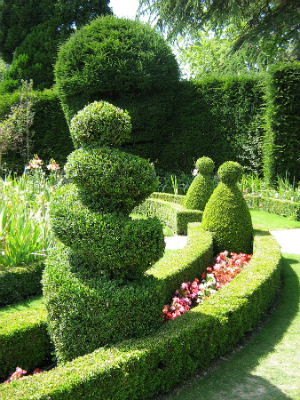Formal-style gardens have stood the test of time — and for good reason
Story: Dean Boone, MAILDM
Photos: Diane Norris
The formal garden would have to be one of the most enduring styles of garden design the world over, but what is it that makes a formal garden timeless?
Well first, let’s look at what it is about a traditional formal garden that we find so appealing. The answer lies within us: humans like order. We like straight lines, defined spaces, structure, control of nature and a sense that the wild is something “out there” … not in our own backyard. Formal gardens give us that in one neat, spectacular package. Lines of green, shaped plants and tidy gardens where colours and forms are repeated to create the order we crave.
Formal gardens are synonymous with balance, structure and symmetry. In fact, the easiest way to create order in a garden is to introduce straight lines. Even the messiest of gardens takes on an air of refined elegance if you add a hedge or two, and what formal garden would be complete without hedges?
Formal gardens are about simple, classic elegance, although history has given us some monstrous overstatements of power and wealth, such as the grounds of the Palace of Versailles in France. But whether large- or small-scale, formal gardens use defined design structure in an almost geometric manner to create space, swathes of colour and, most importantly of all, lines within a garden.
Formal gardens have remained popular for one simple reason. We like them. They make us feel good, they look good and they create order in nature. For gardeners with less than a green thumb or no sense of design, a basic formal garden is still achievable. I know from designing gardens that a formal layout is able to resolve problems on a difficult site, is great for drawing the eye to a favourable view and away from something unsightly and is a really simple way of creating instant elegance.
Wild and natural gardens go in and out of favour, but formal gardens, in all their forms, have remained with us for generations. Formal gardens don’t just have to be English or French in style. We can see fine examples of formalised gardens in Japan — just think of raked gravel and clipped shrubbery — or in India. The Taj Mahal and its gardens are considered one of the greatest statements in symmetry.
So what homes best complement a formal garden? The answer is easy: formal garden design can be incorporated into any garden and, broadly speaking, most have some element of formality in them, anyway. The difference is just the level of formality.
Small blocks in new suburbs can benefit from a formal garden design because it defines small spaces and creates a perception of increased depth. And the entrance to any style of house when framed by a pair of flowering trees takes on a new perspective. The combinations are endless and the results are always the same — stunning.
You may be wondering how we can adapt formal garden design principles to complement contemporary home design and our modern lifestyle. A modern formal garden will certainly use different materials from its more traditional cousin, and will typically take its colour cues from the façade of the house. This might involve the use lots of bold architectural foliage, swathes of succulents and splashes of plum colours, all of which certainly reflect the character of many contemporary homes.
The design layout, however, need not differ greatly from that of traditional formal gardens. Framed views, defined spaces, repetition of plant material and hedges (fashioned from native lilly pilly) are all found in the modern formal garden. And just like traditional formal gardens, the new formal garden looks great.




